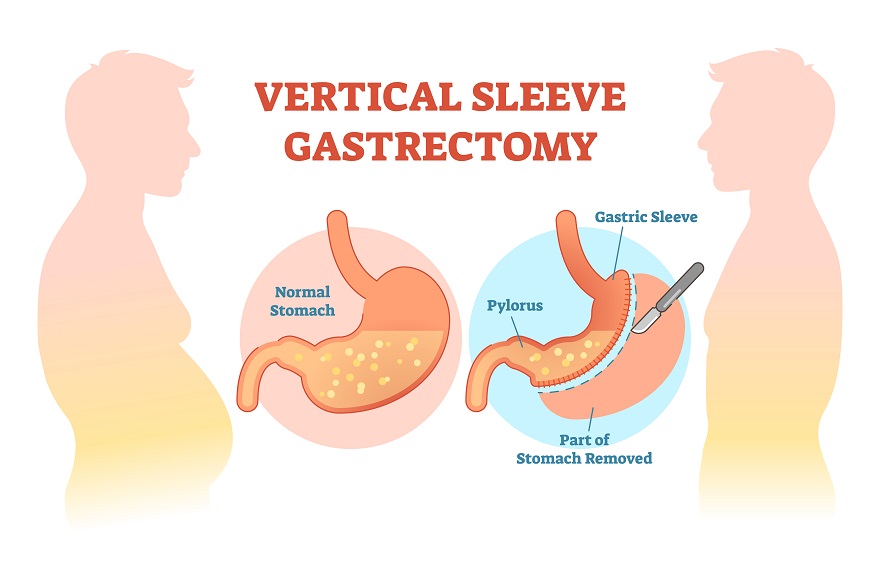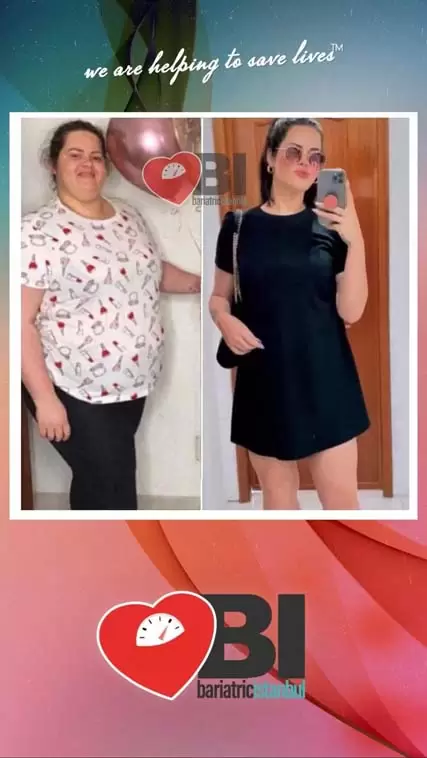Gastric Sleeve Istanbul
Gastric Sleeve Turkey Packages
bariatric istanbul performs gastric sleeve surgery, known as gastric sleeve turkey, in its Istanbul-based hospitals with a 99% success rate. bariatric istanbul offers the best quality gastric sleeve surgery turkey with affordable costs.
Gastric Sleeve Turkey
A sleeve gastrectomy, or gastric sleeve, is a weight loss surgery that involves reducing the size of the stomach. It has become one of the most popular bariatric procedures due to its many advantages over other types of weight-loss surgeries. The primary advantage of having a gastric sleeve is that it can help individuals achieve substantial and sustained weight loss. This procedure removes roughly 75-85% of the stomach, leaving a narrow tube or sleeve in its place. By limiting the amount of food intake, this procedure effectively reduces caloric consumption and results in significant weight loss. Additionally, since this type of surgery does not involve any rearrangement or rerouting of the digestive system, there are fewer risks associated with it and potential complications are minimal.

Other advantages of a gastric sleeve turkey include improved health and quality of life. With significant weight loss usually comes an improvement in metabolic and physical health, including the reversal or prevention of diseases such as diabetes, sleep apnea, heart disease, and more. Sleeve gastrectomy also helps reduce hunger cravings and increases satiety after meals. Since the surgery reduces ghrelin (the “hunger hormone”) production and only removes a portion of the stomach, individuals tend to feel fuller faster and for longer periods with less food consumed. Ultimately, this leads to lower overall calorie intake which contributes to healthier eating habits in the long-term.
Therefore, by reducing hunger cravings while still allowing individuals to eat regular meals, gastric sleeve surgery is an effective weight loss procedure that can also help improve one's physical health. Additionally, many people report improved self-esteem and more confidence as a result of their successful weight loss journey post-surgery. Along with the physical benefits, there are psychological benefits as well – patients often feel more energized and motivated to maintain their newly achieved healthy lifestyle.
In conclusion, sleeve gastrectomy offers numerous advantages for individuals struggling with obesity: improved physical health outcomes; lower appetite and hunger cravings; greater satiety after meals; increased energy levels; improved self-esteem and more confidence. Ultimately, these factors contribute to healthier eating habits in the long run and make it easier for individuals to reach and maintain their weight loss goals.
Sleeve gastrectomy is a safe and effective procedure that can help individuals take control of their health for the better. With the right dietary changes, exercise regimen and lifestyle adjustments, sleeve gastrectomy can be an invaluable tool on your weight loss journey.
By committing to this procedure, you are taking an important step in improving your overall wellbeing and quality of life.
Free Consultation
Get Information about Gastric Sleeve
by filling out the form, you can get more information about bariatric surgeries and get service from Bariatric Istanbul Angels for before and after all bariatric surgery.
We are here to answer whatever you have in mind!
Gastric Sleeve Turkey Before&After Photos































































Gastric Sleeve Advantages
Sleeve gastrectomy, also known as gastric sleeve surgery, is a procedure developed to help individuals achieve and maintain significant weight loss. This procedure carries many advantages, including:
Weight Loss – A great benefit of the gastric sleeve is its ability to produce steady and sustainable weight loss over time. Since it drastically reduces the size of the stomach, individuals are not able to consume large amounts of food in one sitting. This ultimately leads to fewer calories being consumed throughout the day and encourages natural weight loss.
Reduced Appetite – Another advantage of the gastric sleeve is that it can reduce appetite by altering levels of hunger hormones in the body. By reducing your sense of hunger and cravings you can avoid potential triggers that can lead to overeating.
Low Risk of Complications – The gastric sleeve is a relatively low risk procedure with minimal complications and side effects. It also does not require any foreign objects or devices to be inserted into the body, which reduces the chances for infection.
Improved Health – By encouraging weight loss and reducing hunger, the gastric sleeve can improve overall health. This includes a lower risk of heart disease, stroke, diabetes, and other conditions associated with obesity. It can also help to reduce cholesterol and blood pressure levels.
Quick Recovery – Another advantage of the gastric sleeve is that it has a relatively quick recovery time compared to other types of bariatric surgeries. Patients can typically resume their normal activities within two weeks and achieve significant weight loss in the first six months.
Reduced Appetite – One of the primary advantages of the gastric sleeve is that it has been found to reduce hunger and minimize cravings for food. This helps patients to feel fuller quicker, eat lesser amounts, and eventually lose weight.
Fewer Complications – Gastric sleeve surgery has been found to have fewer complications than other types of bariatric surgeries such as gastric bypass or duodenal switch. This is because the procedure involves fewer changes in the digestive system, meaning there are less risks associated with it.
Diseases that occur due to obesity and disappear completely or improve considerably with the loss of excess weight.
Gastric Sleeve Disadvantages
The gastric sleeve, also known as a sleeve gastrectomy, is a surgical weight-loss treatment that involves removing part of the stomach and creating a small banana-shaped pouch in its place. The operation can be effective for people who are obese or severely overweight, but there are some potential gastric sleeve disadvantages to consider before making the decision to undergo the surgery.
One of the main gastric sleeve disadvantages is that it is not as effective in treating obesity or severe weight problems as other surgical treatments such as Roux-en-Y gastric bypass and duodenal switch. The procedure also typically requires general anesthesia, which carries risks and can cause some nausea and dizziness after the surgery is completed.
Another potential disadvantage of gastric sleeve surgery is that it may not be an appropriate option for people with more severe medical conditions such as diabetes, high blood pressure, sleep apnea, or heart disease. These patients may need to consider other types of weight loss surgeries instead.
Gastric sleeve surgery also carries risks of some side effects, such as vitamin and mineral deficiencies, because the small stomach pouch cannot absorb them efficiently. As a result, people who undergo this procedure will need to take supplements regularly to ensure they are getting adequate nutrition.
In addition, it is important to note that gastric sleeve surgery is not reversible and the procedure can cause some internal scarring. This could affect the body’s ability to absorb nutrients over time, so it is important to be aware of this potential issue before making a decision.
Finally, gastric sleeve surgery is not always successful at treating obesity in the long-term; many patients find that they regain some of their weight after the procedure. This is because the surgery does not address any underlying health conditions or lifestyle habits that may be contributing to weight gain. As such, people who undergo gastric sleeve surgery should take steps to ensure they are making healthy diet and exercise changes in order to achieve lasting results.
Overall, there are both benefits and disadvantages of gastric sleeve surgery. While the procedure can reduce hunger and help people lose a significant amount of weight, it is important to consider potential risks such as infection, nausea, bleeding, and the possibility that some weight may be regained after the procedure. As always, it’s best to speak with a qualified doctor or medical professional before making any major health decisions.
It is ultimately up to the individual patient to decide if the potential benefits of gastric sleeve surgery outweigh the risks and side effects. With proper guidance, a healthy lifestyle, and realistic expectations, many people who undergo sleeve gastrectomy can achieve long-term weight loss success.
Gastric Sleeve Overall Requirements
Gastric Sleeve overview in istanbul
Gastric Sleeve Turkey Prices
Bariatric Istanbul have 4 different packages for gastric sleeve, gastric sleeve turkey.
you can check bariatric istanbul surgery packages and directly can book your surgery for gastric sleeve, gastric sleeve turkey.
We offer competitive gastric sleeve prices in Turkey, allowing our customers to take advantage of the best healthcare services at an affordable rate. Our packages also provide access to our top-notch medical team, who are experts in providing the best possible care before and after your procedure. We also provide a variety of follow up services to ensure that your health and wellbeing are taken care of in the long-term. With our competitive gastric sleeve turkey prices, you can be sure to get the best care at a cost that suits your budget. Contact us today to find out more about our gastric sleeve packages and prices.
We look forward to hearing from you!
Gastric Sleeve Surgery Benefits
There are 5-6 surgical options in the treatment of morbid obesity. gastric sleeve turkey is one of the most commonly used methods. Your doctor will recommend the most suitable surgical options for you after evaluating your weight, comorbidities and surgical risks.
Your life will change in a few months. Do not miss the chance given to you to return to life and live a life free from obesity.
Sleeve gastrectomy surgery is a proven and effective weight loss solution for those who are obese or overweight. It can help you to lose excess body fat, reduce health risks associated with obesity, and improve your overall quality of life. Here are some of the benefits of sleeve gastrectomy surgery:
- Long-term Weight Loss:
Studies have shown that sleeve gastrectomy surgery can result in long-term weight loss, with some patients achieving up to 50% of their excess body weight within the first year. - Reduced Health Risks:
A key benefit of sleeve gastrectomy surgery is improved health and a reduction in many of the risks associated with being overweight or obese, including type 2 diabetes, high cholesterol, and high blood pressure. - Reduced Appetite:
A major cause of weight gain is uncontrolled hunger. With sleeve gastrectomy surgery, the stomach size is reduced permanently which can reduce appetite and make it easier for you to stay on your diet. - Improved Quality of Life:
Patients who undergo sleeve gastrectomy surgery often report a significant improvement in their quality of life, due to the benefits of weight loss and improved health. - Increased Self-Confidence:
Weight loss can have a positive effect on your self-esteem. With increased self-confidence, you may feel more comfortable attending events or engaging in activities you may have otherwise avoided due to your weight. - Improved Health:
Weight loss can also lead to improved health, as it can reduce the risk of certain chronic conditions such as diabetes and heart disease. Additionally, with fewer fat cells in your body, your metabolism can improve which can lead to better overall health. - Reduced Risk of Disease:
Studies have shown that sleeve gastrectomy surgery can reduce the risk of developing certain diseases such as Type 2 Diabetes, heart disease and even some types of cancer. This is due to the fact that weight loss improves your overall health and reduces fatty acids in your body which can lead to inflammation. - Improved Self-Esteem and Confidence:
Weight loss can improve your mental health by boosting your self-esteem and increasing confidence. Studies have shown that weight loss from sleeve gastrectomy surgery can lead to improved self-image, better social relationships, and even an improved mood. - Long Term Results:
Studies have shown that sleeve gastrectomy can lead to long-term weight loss, with patients maintaining their new weight for up to five years after the procedure. This is due to the fact that it reduces the amount of food your stomach can hold, making you feel fuller faster and discouraging overeating. - Reduced Risk of Disease:
Excess weight can put you at higher risk of developing serious health conditions, such as type 2 diabetes, heart disease and stroke. Sleeve gastrectomy surgery has been shown to reduce the risk of these diseases by up to 50%. It also helps lower blood pressure, reduces inflammation and improves cholesterol levels. - Improved Quality of Life:
Patients who undergo sleeve gastrectomy surgery often report feeling better overall, with increased energy levels and improved mood. They also have more confidence in their appearance and a greater sense of self-esteem. This can help them to be more engaged activities and relationships. - Easier Maintenance:
Since this procedure does not involve the intestines or stomach, there is less maintenance required than with other types of bariatric surgery. - Reduced Hunger:
Patients who undergo sleeve gastrectomy surgery experience significantly reduced hunger levels, allowing them to better control their weight and make healthier food choices. This can help prevent overeating or unhealthy snacking. - Faster Recovery Time:
Unlike other types of bariatric surgery, the recovery period for a sleeve gastrectomy is relatively quick. Most patients can return to their normal activities within two weeks of the procedure. - Improved Health:
Studies have shown that those who undergo sleeve gastrectomy surgery experience improved blood pressure, cholesterol levels and blood sugar levels as well as lower risk for cardiovascular disease and type 2 diabetes. - Fewer Nutritional Deficiencies:
Traditional bariatric procedures involve rerouting the digestive system, which can lead to nutrient deficiencies. Sleeve gastrectomy surgery does not interfere with the digestive process, leaving fewer chances of nutritional deficiencies.
Numbers of Bariatric Istanbul
Learn more about the Success Stories
Numbers of Bariatric Istanbul can explain the success rates for our bariatric surgeries. bariatric surgery turkey
Why you should choose us?
why what we do makes us more exceptional than others.
Our mission is based on providing a quality life to all humanity by staying at a healthier weight. This is exactly why we plan and perform bariatric surgeries.
Our priority; It is to improve people’s quality of life and help them build a happy future.
Bariatric surgery operation guaranteed by bariatric and metabolic surgeons with more than 30 years of experience.
Professionally trained and experienced nurse and help team for aftercare with bariatric surgery.
The best care and nurse services. Continuous follow-up with special dietitian and representative support.
The hospitals in the comfort of a 5-star hotel where everything is considered for your comfort and healing process.
State-of-the-art laparoscopic surgeries with FDA approved medical equipment. The most important thing is your health.
